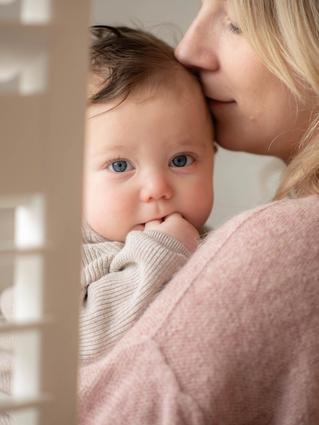
- Home
- Tools And Resources
- Baby Development Calendar
- 5 Months Old Baby | Milestones & Weaning Prep
5 months old
3 min
Babies of this age…
- Constantly repeat sounds, e.g. blowing raspberries
- Love taking turns with you making noises
- Can see and focus on objects and people across a room
- Will look around with interest and will watch you from a distance
- Will flex their head forward when pulled from a lying into a sitting position
- May be starting to dribble a lot because of teething - symptoms can start around a month before a tooth actually appears.
- Babies may now roll from their backs to their fronts and are now able to push up on their arms when they are on their tummies.
Your baby…
- Being held or propped up in a sitting position gives your baby a whole new perspective on the world
- Putting toys just out of reach during tummy time encourages your baby to stretch and move (it’s surprising how far they can travel!)
- Talking to babies about anything and everything is important in helping them to learn
- Games such as ‘peek a boo’, ‘pat-a-cake, pat-a-cake’, ‘walky round the garden like a teddy bear’, ‘this little piggy’ and ‘incy-wincy spider’ will be a big hit!
This is an enchanting time…mostly!
So many skills are being learnt, and it's such fun to sing, play games and make silly noises and faces with your baby. When you see the world through a baby’s eyes, it becomes a magical place.
But sometimes, if your baby is crying without apparent reason, seems to need constant attention, or won’t sleep, it can be a little overwhelming. That’s why getting together with other parents of young babies provides such great support. It's worth making the effort to keep up with the new mums and dads you met at antenatal classes, or finding any local parent groups that meet regularly (your health visitor may know of some). It's also a good idea to try to organise a babysitter now and then so that you can have a bit of a baby-free social life, too.
Teething
If your baby has been unsettled, dribbling or chewing on everything, teething may well be the culprit. You'll know for sure the day a little white tooth magically appears! The first tooth to appear is usually one of the bottom front ones, followed by the one next to it; then come the top middle two in turn. Most babies start getting teeth around six months, but a few have no teeth until they are around a year or even older!
Weaning your baby
There’s a whole exciting world of foods out there just waiting for your baby to explore (teeth or no teeth!). Before diving in, it’s worth knowing that most health professionals recommend starting weaning from around 6 months.
Some babies may show signs of readiness a little earlier, but it’s important not to start before 17 weeks, as your baby’s digestive system may not be fully developed. If you’re unsure, it’s always a good idea to check in with your health visitor or GP before getting started.
When your baby is ready for weaning, you’ll likely notice a few key signs:
- They can sit upright with support and hold their head steady
- They’re able to coordinate their hands, eyes and mouth to pick up food and try to eat it
- They can swallow food, rather than pushing it back out with their tongue
Not sure about that last one? Try offering a tiny bit of smooth purée on a weaning spoon or clean finger. If it comes straight back out, no worries – just try again another day.
And don’t worry about keeping up with others – there’s no rush. Your baby’s usual milk is still providing all the nourishment they need for now.
For all the (delightfully messy) details about how to start weaning, head over to our weaning your baby section – and maybe pop a wipeable mat on the floor while you're at it!
